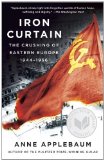Summary | Excerpt | Reviews | Beyond the Book | Readalikes | Genres & Themes | Author Bio

Critics' Opinion:
Readers' Opinion:
First Published:
Oct 2012, 608 pages
Paperback:
Aug 2013, 640 pages
 Book Reviewed by:
Book Reviewed by:
Kim Kovacs
Buy This Book
But they would fail again. Following Stalin's death in 1953, a series of minor and major rebellions broke out across the region. In 1953, East Berliners staged a protest which ended with Soviet tanks. Two major uprisings followed in 1956, in Poland and Hungary. In the wake of those uprisings the East European communists would moderate their tactics once again. They would continue to fail – and continue to change tactics – until they finally gave up power altogether in 1989 . Between 1945 and 1953, the Soviet Union radically transformed an entire region, from the Baltic to the Adriatic, from the heart of the European continent to its southern and eastern peripheries. But in this book, I will focus on Central Europe. Though referring to Czechoslovakia, Romania and Bulgaria as well as Yugoslavia, I will focus in particular on Hungary, Poland and Eastern Germany. I have chosen these three countries not because they were similar, but because they were so very different.
Above all, they had different experiences of war. Germany had, of course, been the main aggressor and then the biggest loser. Poland had fought hard against German occupation and was one of the Allies, although it did not share in the fruits of victory. Hungary had played a role somewhere in between, experimenting with authoritarianism, collaborating with Germany, trying to switch sides and then finding it was too late. These three countries also had very different historical experiences. Germany had been the dominant economic and political power in Central Europe for decades. Poland, although a continental empire through the seventeenth century, had been partitioned by three other empires in the eighteenth century and lost its sovereignty in 1795 , regaining it only in 1918 . Hungary's power and influence had meanwhile peaked in the early part of the twentieth century. After the First World War, Hungary lost two thirds of its territory, an experience so traumatic that it has echoes in Hungarian politics even today.
None of the three had been democratic, strictly speaking, in the period immediately preceding the war. But they all had experience of political liberalism, constitutional government and elections. All had stock markets, foreign investment, limited companies, and laws protecting property rights. All had civic institutions – churches, youth organizations, trade associations – dating back hundreds of years, as well as long traditions of press, printing and publication. Poland's first newspaper had appeared in 1661 . Germans had produced an enormous array of competing media before Hitler's rise to power in 1933 . All had elaborate economic and cultural ties to Western Europe, far stronger in the 1930 s than their ties to Russia. Nothing in their history or their culture automatically destined them to become totalitarian dictatorships. Western Germany, although culturally identical to Eastern Germany, became a liberal democracy as did Austria, which had long been part of the Habsburg Empire alongside Czechoslovakia and Hungary.
History sometimes looks inevitable in retrospect, and in the decades following the imposition of communism some sought post-hoc rationales for the Eastern European communist regimes. The eastern half of the continent was said to be poorer than the western half (except, of course, that Germany wasn't); the nations of the region were said to be less developed (except that by comparison to Greece, Spain and Portugal, Hungary and Poland weren't) or less industrialized (except that the Czech lands were among the most industrialized in Europe). But from the perspective of 1945, no one looking forward foresaw that Hungary, with its long ties to the German-speaking lands in the West; Poland, with its fierce anti-Bolshevik tradition; or eastern Germany, with its Nazi past, would remain under Soviet political control for nearly half a century.
When they did fall under Soviet political control, few outside the region understood what happened and why. Even now, many continue to see Eastern Europe solely through the prism of the Cold War. With some exceptions, Western books about postwar Eastern Europe have most often focused on East–West conflict; on Germany's division ('The German Question'); and on the creation of NATO and the Warsaw Pact. 29 Hannah Arendt herself dismissed the region's postwar history as uninteresting: 'It was as though the Russian rulers repeated in great haste all the stages of the October revolution up to the emergence of totalitarian dictatorship; the story, therefore, while unspeakably terrible, is without much interest of its own and varies very little.'
Excerpted from Iron Curtain by Anne Applebaum. Copyright © 2012 by Anne Applebaum. Excerpted by permission of Doubleday. All rights reserved. No part of this excerpt may be reproduced or reprinted without permission in writing from the publisher.





The House on Biscayne Bay
by Chanel Cleeton
As death stalks a gothic mansion in Miami, the lives of two women intertwine as the past and present collide.

The Flower Sisters
by Michelle Collins Anderson
From the new Fannie Flagg of the Ozarks, a richly-woven story of family, forgiveness, and reinvention.

The Funeral Cryer by Wenyan Lu
Debut novelist Wenyan Lu brings us this witty yet profound story about one woman's midlife reawakening in contemporary rural China.
Your guide toexceptional books
BookBrowse seeks out and recommends the best in contemporary fiction and nonfiction—books that not only engage and entertain but also deepen our understanding of ourselves and the world around us.